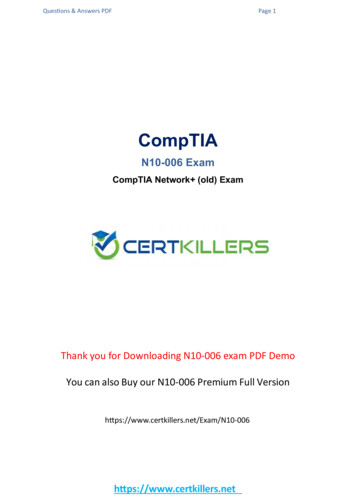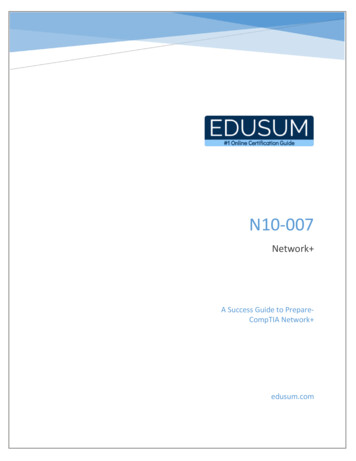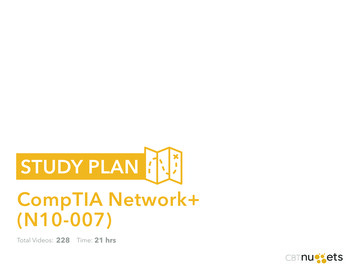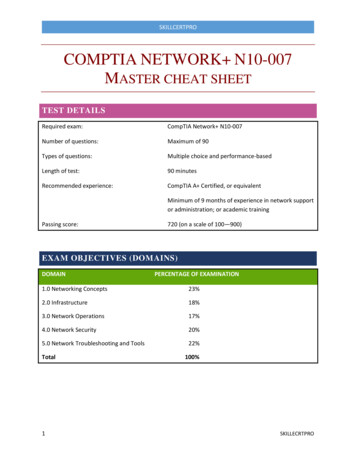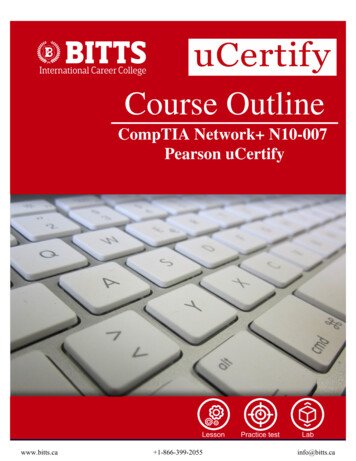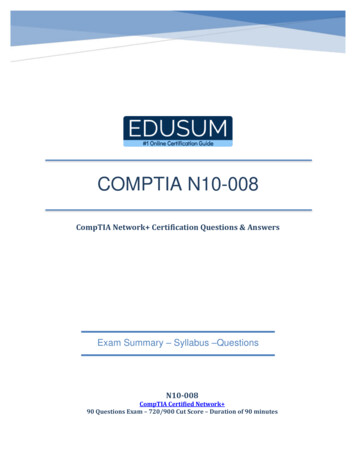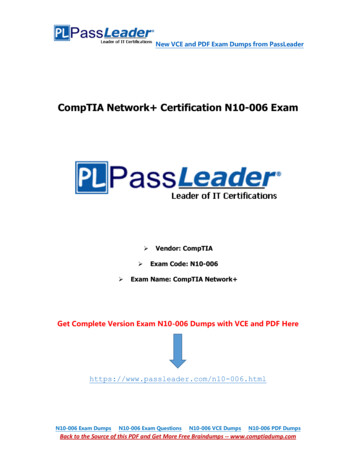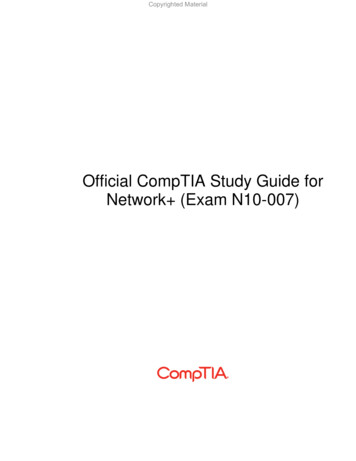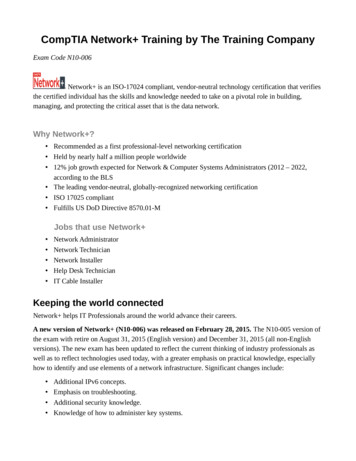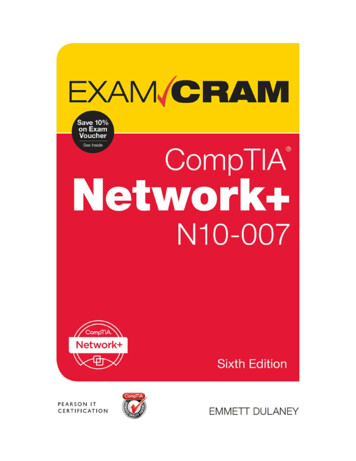
Transcription
Comptia network n10-007 cert guide download pdf download online pc
Comptia network n10-007 cert guide download pdf download online pcLearn, prepare, and practice for CompTIA Network N10-007 exam success with this CompTIA approved Cert Guide from Pearson IT Certification, a leader in IT Certification learning and a CompTIA Authorized Platinum Partner.Master CompTIA Network N10-007 exam topicsAssess your knowledge with chapter-ending quizzesReview key conceptswith exam preparation tasksPractice with realistic exam questionsLearn from more than 60 minutes of video mentoringCompTIA Network N10-007 Cert Guide is a best-of-breed exam study guide. Best-selling author and expert instructor Anthony Sequeira shares preparation hints and test-taking tips, helping you identify areas of weakness andimprove both your conceptual knowledge and hands-on skills. Material is presented in a concise manner, focusing on increasing your understanding and retention of exam topics. The book presents you with an organized test preparation routine through the use of proven series elements and techniques. Exam topic lists make referencing easy.Chapter-ending Exam Preparation Tasks help you drill on key concepts you must know thoroughly. Review questions help you assess your knowledge, and a final preparation chapter guides you through tools and resources to help you craft your final study plan. The companion website contains a host of tools to help you prepare for the exam,including:The powerful Pearson Test Prep practice test software, complete with hundreds of exam-realistic questions. The assessment engine offers you a wealth of customization options and reporting features, laying out a complete assessment of your knowledge to help you focus your study where it is needed most. More than 60 minutes of personalvideo mentoring40 performance-based exercises to help you prepare for the performance-based questions on the examThe CompTIA Network N10-007 Hands-on Lab Simulator Lite software, complete with meaningful exercises that help you hone your hands-on skillsAn interactive Exam Essentials appendix that quickly recaps all major chaptertopics for easy referenceA key terms glossary flash card applicationMemory table review exercises and answersA study planner to help you organize and optimize your study timeA 10% exam discount voucher (a 27 value!)Well-regarded for its level of detail, assessment features, and challenging review questions and exercises, this CompTIAapproved study guide helps you master the concepts and techniques that will enable you to succeed on the exam the first time.The CompTIA approved study guide helps you master all the topics on the Network exam, including:Computer networks and the OSI modelNetwork componentsEthernetIP addressingRouting trafficWide Area Networks(WANs)Wireless TechnologiesNetwork performanceCommand-line utilitiesNetwork managementNetwork policies and best practicesNetwork securityTroubleshootingPearson Test Prep system requirements: Online: Browsers: Chrome version 40 and above; Firefox version 35 and above; Safari version 7; Internet Explorer 10, 11; Microsoft Edge;Opera. Devices: Desktop and laptop computers, tablets running on Android and iOS, smartphones with a minimum screen size of 4.7". Internet access required. Offline: Windows 10, Windows 8.1, Windows 7; Microsoft .NET Framework 4.5 Client; Pentium-class 1 GHz processor (or equivalent); 512 MB RAM; 650 MB disk space plus 50 MB for eachdownloaded practice exam; access to the Internet to register and download exam databasesLab Simulator Minimum System Requirements:Windows: Microsoft Windows 10, Windows 8.1, Windows 7 with SP1; Intel Pentium III or faster; 512 MB RAM (1GB recommended); 1.5 GB hard disk space; 32-bit color depth at 1024x768 resolution Mac: ApplemacOS 10.13, 10.12, 10.11, 10.10; Intel Core Duo 1.83 Ghz or faster; 512 MB RAM (1 GB recommended); 1.5 GB hard disk space; 32-bit color depth at 1024x768 resolution Other applications installed during installation: Adobe AIR 3.8; Captive JRE 6 Get full access to CompTIA Network N10-007 Cert Guide and 60K other titles, with free 10-daytrial of O'Reilly. There's also live online events, interactive content, certification prep materials, and more. CompTIA Network N-7 Cert Guide contains proven study features that enable you to succeed on the exam the first time. Best-selling author and epert instructors Anthony Sequeira and Keith Barker share preparation hints and test-taking tips,helping you identify areas of weakness and improve both your conceptual knowledge and hands-on skills. This complete study package includes:A test-preparation routine proven to help you pass the examsDo I Know This Already? quizzes, which enable you to decide how much time you need to spend on each sectionChapter-ending and part-endingexercises, which help you drill on key concepts you must know thoroughlyThe powerful Pearson IT Certification Practice Test software, complete with hundreds of well-reviewed, exam-realistic questions, customization options, and detailed performance reportsA 7% discount off the Premium Edition eBook and Practice TestA free copy of the CompTIANetwork Simulator Lite software, complete with meaningful lab exercises that help you hone your hands-on skills with the command-line interface for routers and switchesMore than minutes of video mentoring from the authorA final preparation chapter, which guides you through tools and resources to help you craft your review and test-takingstrategiesStudy plan suggestions and templates to help you organize and optimize your study timeWell regarded for its level of detail, study plans, assessment features, challenging review questions and exercises, video instruction, and hands-on labs, this authorized study guide helps you master the concepts and techniques that ensure your examsuccess.This title includes additional digital media when purchased in print format. For this digital book edition, media content may not be included. Contact the publisher's customer service directly for assistance. book Networking Essentials: A CompTIA Network N10-007 Textbook, Fifth Edition by Piyasat Nilkaew, Jeffrey S. Beasley Thoroughlyupdated to reflect the CompTIA Network N10-007 exam, Networking Essentials, Fifth Edition is a practical, book Network Defense and Countermeasures: Principles and Practices, Third edition by Chuck Easttom All you need to know about defending networks, in one book Clearly explains concepts, terminology, challenges, video PythonFundamentals by Paul J. Deitel 51 hours of video instruction. Overview The professional programmer’s Deitel video guide to Python development with book CompTIA Security Review Guide, 4th Edition by James M. Stewart Consolidate your knowledge base with critical Security review CompTIA Security Review Guide, Fourth Edition, is the About This E-Book EPUB is an open, industry-standard format for e-books. However, support for EPUB and its many features varies across reading devices and applications. Use your device or app settings to customize the presentation to your liking. Settings that you can customize often include font, font size, single or double column, landscape orportrait mode, and figures that you can click or tap to enlarge. For additional information about the settings and features on your reading device or app, visit the device manufacturer’s Web site. Many titles include programming code or configuration examples. To optimize the presentation of these elements, view the e-book in single-column,landscape mode and adjust the font size to the smallest setting. In addition to presenting code and configurations in the reflowable text format, we have included images of the code that mimic the presentation found in the print book; therefore, where the reflowable format may compromise the presentation of the code listing, you will see a “Clickhere to view code image” link. Click the link to view the print-fidelity code image. To return to the previous page viewed, click the Back button on your device or app. CompTIA Network N10-007 Cert Guide Anthony Sequeira, CCIE No. 15626 Pearson IT Certification 800 East 96th Street Indianapolis, Indiana 46240 USA CompTIA Network N10007 Cert Guide Anthony Sequeira Copyright 2018 Pearson IT Certification All rights reserved. No part of this book shall be reproduced, stored in a retrieval system, or transmitted by any means, electronic, mechanical, photocopying, recording, or otherwise, without written permission from the publisher. No patent liability is assumed with respectto the use of the information contained herein. Although every precaution has been taken in the preparation of this book, the publisher and author assume no responsibility for errors or omissions. Nor is any liability assumed for damages resulting from the use of the information contained herein. ISBN-13: 978-0-7897-5981-8 ISBN-10: 0-7897-5981-0Library of Congress Control Number: 2017957346 Printed in the United States of America 01 18 Trademarks All terms mentioned in this book that are known to be trademarks or service marks have been appropriately capitalized. Pearson IT Certification cannot attest to the accuracy of this information. Use of a term in this book should not beregarded as affecting the validity of any trademark or service mark. Warning and Disclaimer This book is designed to provide information about IT networking in the scope of the CompTIA Network exam. Every effort has been made to make this book as complete and as accurate as possible, but no warranty or fitness is implied. The information isprovided on an “as is” basis. The author shall have neither liability nor responsibility to any person or entity with respect to any loss or damages arising from the information contained in this book or from the use of the discs or programs that may accompany it. The opinions expressed in this book belong to the author and are not necessarily those ofPearson. Special Sales For information about buying this title in bulk quantities, or for special sales opportunities (which may include electronic versions; custom cover designs; and content particular to your business, training goals, marketing focus, or branding interests), please contact our corporate sales department at [email protected] or (800)382-3419. For government sales inquiries, please contact [email protected] For questions about sales outside the U.S., please contact [email protected] Editor-in-Chief Mark Taub Product Line Manager Brett Bartow Managing Editor Sandra Schroeder Development Editor Marianne Bartow Project Editor Mandie Frank Copy Editor Bart ReedTechnical Editor Robert Fleming Editorial Assistant Vanessa Evans Designer Chuti Prasertsith Composition Studio Galou Indexer Heather McNeill Proofreader Paula Lowell Contents at a Glance Introduction CHAPTER 1 Computer Network Fundamentals CHAPTER 2 The OSI Reference Model CHAPTER 3 Network Components CHAPTER 4 EthernetTechnology CHAPTER 5 IPv4 and IPv6 Addresses CHAPTER 6 Routing IP Packets CHAPTER 7 Wide Area Networks (WANs) CHAPTER 8 Wireless Technologies CHAPTER 9 Network Optimization CHAPTER 10 Command-Line Tools CHAPTER 11 Network Management CHAPTER 12 Network Security CHAPTER 13 Network Policies and Best PracticesCHAPTER 14 Network Troubleshooting CHAPTER 15 Final Preparation APPENDIX A Answers to Review Questions APPENDIX B CompTIA Network N10-07 Cert Guide Exam Updates Glossary Index ONLINE ELEMENTS: APPENDIX C Memory Tables APPENDIX D Memory Tables Answer Key APPENDIX E Study Planner Exam Essentials InteractiveStudy Guide Key Terms Flash Cards Application Instructional Videos Performance-Based Exercises CompTIA Network N10-007 Hands-on Lab Simulator Lite Software Table of Contents Introduction Chapter 1 Computer Network Fundamentals Foundation Topics Defining a Network The Purpose of Networks Overview of Network ComponentsNetworks Defined by Geography LAN WAN WLAN SAN Other Categories of Networks CAN MAN PAN Networks Defined by Topology Physical Versus Logical Topology Bus Topology Ring Topology Star Topology Hub-and-Spoke Topology Full-Mesh Topology Partial-Mesh Topology Wireless Topologies Ad Hoc Infrastructure Mesh Networks Defined byResource Location Client/Server Networks Peer-to-Peer Networks Real-World Case Study Summary Exam Preparation Tasks Review All the Key Topics Complete Tables and Lists from Memory Define Key Terms Complete Chapter 1 Hands-On Lab in Network Simulator Lite Additional Resources Review Questions Chapter 2 The OSI Reference ModelFoundation Topics The Purpose of Reference Models The OSI Model Layer 1: The Physical Layer Layer 2: The Data Link Layer Media Access Control Logical Link Control Layer 3: The Network Layer Layer 4: The Transport Layer Layer 5: The Session Layer Layer 6: The Presentation Layer Layer 7: The Application Layer The TCP/IP Stack Layers of theTCP/IP Stack Common Application Protocols in the TCP/IP Stack Real-World Case Study Summary Exam Preparation Tasks Review All the Key Topics Complete Tables and Lists from Memory Define Key Terms Complete Chapter 2 Hands-On Labs in Network Simulator Lite Additional Resources Review Questions Chapter 3 Network ComponentsFoundation Topics Media Coaxial Cable Twisted-Pair Cable Shielded Twisted Pair Unshielded Twisted Pair Plenum Versus Nonplenum Cable Fiber-Optic Cable Multimode Fiber Single-Mode Fiber Fiber Connector Polishing Styles Media Converters Cable Distribution Wireless Technologies Technologies for the Internet of Things NetworkInfrastructure Devices Hubs Bridges Switches Multilayer Switches Routers Infrastructure Device Summary Specialized Network Devices VPN Concentrators Firewalls DNS Servers DHCP Servers Proxy Servers Content Engines Content Switches Other Specialized Devices Virtual Network Devices Virtual Servers Virtual Routers and Firewalls VirtualSwitches Virtual Desktops Other Virtualization Solutions Cloud Computing Software-Defined Networking (SDN) Voice over IP Protocols and Components Real-World Case Study Summary Exam Preparation Tasks Review All the Key Topics Complete Tables and Lists from Memory Define Key Terms Complete Chapter 3 Hands-On Labs in Network Simulator Lite Additional Resources Review Questions Chapter 4 Ethernet Technology Foundation Topics Principles of Ethernet Ethernet Origins Carrier-Sense Multiple Access/Collision Detect Distance and Speed Limitations Ethernet Switch Features Virtual LANs Switch Configuration for an Access Port Trunks Switch Configuration for a Trunk PortSpanning Tree Protocol Corruption of a Switch’s MAC Address Table Broadcast Storms STP Operation Link Aggregation LACP Configuration Power over Ethernet Port Monitoring Port Mirroring Configuration User Authentication Management Access and Authentication First-Hop Redundancy Other Switch Features Real-World Case Study SummaryExam Preparation Tasks Review All the Key Topics Complete Tables and Lists from Memory Define Key Terms Complete Chapter 4 Hands-On Labs in Network Simulator Lite Additional Resources Review Questions Chapter 5 IPv4 and IPv6 Addresses Foundation Topics Binary Numbering Principles of Binary Numbering Converting a Binary Numberto a Decimal Number Converting a Decimal Number to a Binary Number Binary Numbering Practice Binary Conversion Exercise 1 Binary Conversion Exercise 1: Solution Binary Conversion Exercise 2 Binary Conversion Exercise 2: Solution Binary Conversion Exercise 3 Binary Conversion Exercise 3: Solution Binary Conversion Exercise 4 BinaryConversion Exercise 4: Solution IPv4 Addressing IPv4 Address Structure Classes of Addresses Types of Addresses Unicast Broadcast Multicast Assigning IPv4 Addresses IP Addressing Components Static Configuration Dynamic Configuration BOOTP DHCP Automatic Private IP Addressing Subnetting Purpose of Subnetting Subnet Mask NotationSubnet Notation: Practice Exercise 1 Subnet Notation: Practice Exercise 1 Solution Subnet Notation: Practice Exercise 2 Subnet Notation: Practice Exercise 2 Solution Extending a Classful Mask Borrowed Bits Calculating the Number of Created Subnets Calculating the Number of Available Hosts Basic Subnetting Practice: Exercise 1 BasicSubnetting Practice: Exercise 1 Solution Basic Subnetting Practice: Exercise 2 Basic Subnetting Practice: Exercise 2 Solution Calculating New IP Address Ranges Advanced Subnetting Practice: Exercise 1 Advanced Subnetting Practice: Exercise 1 Solution Advanced Subnetting Practice: Exercise 2 Advanced Subnetting Practice: Exercise 2 SolutionAdditional Practice Classless Interdomain Routing IP Version 6 Need for IPv6 IPv6 Address Structure IPv6 Address Types IPv6 Data Flows Unicast Multicast Anycast Real-World Case Study Summary Exam Preparation Tasks Review All the Key Topics Complete Tables and Lists from Memory Define Key Terms Complete Chapter 5 Hands-On Labs inNetwork Simulator Lite Additional Resources Review Questions Chapter 6 Routing IP Packets Foundation Topics Basic Routing Processes Sources of Routing Information Directly Connected Routes Static Routes Dynamic Routing Protocols Routing Protocol Characteristics Believability of a Route Metrics Interior Versus Exterior Gateway ProtocolsRoute Advertisement Method Distance Vector Link State Routing Protocol Examples Address Translation NAT PAT Multicast Routing IGMP PIM PIM-DM PIM-SM Real-World Case Study Summary Exam Preparation Tasks Review All the Key Topics Complete Tables and Lists from Memory Define Key Terms Complete Chapter 6 Hands-On Lab inNetwork Simulator Lite Additional Resources Review Questions Chapter 7 Wide Area Networks (WANs) Foundation Topics WAN Properties WAN Connection Types WAN Data Rates WAN Media Types Physical Media Wireless Media WAN Technologies Dedicated Leased Line T1 E1 T3 E3 CSU/DSU Metro Ethernet Point-to-Point Protocol Point-toPoint Protocol over Ethernet Microsoft RRAS Digital Subscriber Line Cable Modem Synchronous Optical Network Satellite Plain Old Telephone Service Integrated Services Digital Network Frame Relay SIP Trunk Asynchronous Transfer Mode Multiprotocol Label Switching Overlay Networks Real-World Case Study Summary Exam Preparation TasksReview All the Key Topics Complete Tables and Lists from Memory Define Key Terms Complete Chapter 7 Hands-On Lab in Network Simulator Lite Additional Resources Review Questions Chapter 8 Wireless Technologies Foundation Topics Introducing Wireless LANs WLAN Concepts and Components Wireless Routers Wireless Access PointAntennas Frequencies and Channels CSMA/CA Transmission Methods WLAN Standards 802.11a 802.11b 802.11g 802.11n 802.11ac 802.11x Standard Summary Deploying Wireless LANs Types of WLANs IBSS BSS ESS Mesh Topology Sources of Interference Wireless AP Placement Securing Wireless LANs Security Issues Approaches to WLANSecurity Security Standards WEP WPA WPA2 Additional Wireless Options Real-World Case Study Summary Exam Preparation Tasks Review All the Key Topics Complete Tables and Lists from Memory Define Key Terms Complete Chapter 8 Hands-On Lab in Network Simulator Lite Additional Resources Review Questions Chapter 9 NetworkOptimization Foundation Topics High Availability High-Availability Measurement Fault-Tolerant Network Design Hardware Redundancy Layer 3 Redundancy Design Considerations for High-Availability Networks High-Availability Best Practices Content Caching Load Balancing Hardware Redundancy QoS Technologies Introduction to QoS QoSConfiguration Steps QoS Components QoS Mechanisms Classification Marking Congestion Management Congestion Avoidance Policing and Shaping Link Efficiency Case Study: SOHO Network Design Case Study Scenario Suggested Solution IP Addressing Layer 1 Media Layer 2 Devices Layer 3 Devices Wireless Design Environmental Factors CostSavings Versus Performance Topology Real-World Case Study Summary Exam Preparation Tasks Review All the Key Topics Complete Tables and Lists from Memory Define Key Terms Complete Chapter 9 Hands-On Lab in Network Simulator Lite Additional Resources Review Questions Chapter 10 Command-Line Tools Foundation Topics WindowsCommands arp ipconfig nbtstat netstat nslookup ping ping with IPv6 route tracert tracert with IPv6 PathPing UNIX Commands arp dig and nslookup host ifconfig iptables nmap tcpdump traceroute traceroute for IPv6 netstat ping Real-World Case Study Summary Exam Preparation Tasks Review All the Key Topics Complete Tables and Lists fromMemory Define Key Terms Complete Chapter 10 Hands-On Lab in Network Simulator Lite Additional Resources Review Questions Chapter 11 Network Management Foundation Topics Maintenance Tools Bit-Error Rate Tester Butt Set Cable Certifier Cable Tester Connectivity Software Crimper Electrostatic Discharge Wrist Strap EnvironmentalMonitor Loopback Plug Multimeter Protocol Analyzer Wi-Fi Analyzer Looking-Glass Sites Speed Test Sites Punch-Down Tool Throughput Tester Time Domain Reflectometer and Optical Time Domain Reflectometer Toner Probe Spectrum Analyzer Network Documentation Monitoring Resources and Reports SNMP Syslog Logs Application Logs SecurityLogs System Logs Remote Access Methods Real-World Case Study Summary Exam Preparation Tasks Review All the Key Topics Complete Tables and Lists from Memory Define Key Terms Complete Chapter 11 Hands-On Lab in Network Simulator Lite Additional Resources Review Questions Chapter 12 Network Security Foundation Topics SecurityFundamentals Network Security Goals Confidentiality Symmetric Encryption Asymmetric Encryption Integrity Availability Categories of Network Attacks Confidentiality Attacks Integrity Attacks Availability Attacks Logic Bomb Wireless Attacks Denial of Service Distributed Denial of Service TCP SYN Flood Buffer Overflow ICMP Attacks ElectricalDisturbances Attacks on a System’s Physical Environment Defending Against Attacks User Training Patching Security Policies Governing Policy Technical Policies End-User Policies More Detailed Documents Incident Response Vulnerability Scanners Nessus Nmap Honey Pots and Honey Nets Access Control Lists Physical Security Devices NetworkDevice Hardening Layer 2 Protections Remote-Access Security Firewalls Firewall Types Firewall Inspection Types Packet-Filtering Firewall Stateful Firewall Firewall Zones Unified Threat Management Firewalls Virtual Private Networks Overview of IPSec with IKEv1 IKE Modes and Phases Authentication Header and Encapsulating Security PayloadThe Five Steps in Setting Up and Tearing Down an IPSec Site-to-Site VPN Using IKEv1 Other VPN Technologies Intrusion Detection and Prevention IDS Versus IPS IDS and IPS Device Categories Detection Methods Signature-Based Detection Policy-Based Detection Anomaly-Based Detection Deploying Network-Based and Host-Based Solutions RealWorld Case Study Summary Exam Preparation Tasks Review All the Key Topics Complete Tables and Lists from Memory Define Key Terms Complete Chapter 12 Hands-On Lab in Network Simulator Lite Additional Resources Review Questions Chapter 13 Network Policies and Best Practices Foundation Topics Policies Password Policy Data LossPrevention Remote-Access Policies Incident Response Policies Bring Your Own Device (BYOD) Acceptable Use Policy (AUP) Safety Procedures Best Practices Privileged User Agreement (PUA) On-boarding/Off-boarding Procedures Licensing Restrictions International Export Controls Non-Disclosure Agreement (NDA) System Life Cycle Real-WorldCase Study Summary Exam Preparation Tasks Review All the Key Topics Complete Tables and Lists from Memory Define Key Terms Complete Chapter 13 Hands-On Lab in Network Simulator Lite Additional Resources Review Questions Chapter 14 Network Troubleshooting Foundation Topics Troubleshooting Basics Troubleshooting FundamentalsStructured Troubleshooting Methodology Physical Layer Troubleshooting Physical Layer Troubleshooting: Scenario Physical Layer Troubleshooting: Solution Data Link Layer Troubleshooting Data Link Layer Troubleshooting: Scenario Data Link Layer Troubleshooting: Solution Network Layer Troubleshooting Layer 3 Data Structures Common Layer3 Troubleshooting Issues Network Layer Troubleshooting: Scenario Network Layer Troubleshooting: Solution Wireless Troubleshooting Wireless Network Troubleshooting: Scenario Wireless Network Troubleshooting: Solution Specialized Networks Real-World Case Study Troubleshooting Scenarios Summary Exam Preparation Tasks Review All theKey Topics Complete Tables and Lists from Memory Define Key Terms Complete Chapter 14 Hands-On Lab in Network Simulator Lite Additional Resources Review Questions Chapter 15 Final Preparation Tools for Final Preparation Video Training Memory Tables Simulations and Performance-Based Exercises End-of-Chapter Review Tools SuggestedPlan for Final Review and Study Strategies for Taking the Exam Summary Appendix A Answers to Review Questions Appendix B CompTIA Network N10-07 Cert Guide Exam Updates Always Get the Latest at the Book’s Product Page Technical Content Glossary Index ONLINE ELEMENTS: Appendix C Memory Tables Appendix D Memory TablesAnswer Key Appendix E Study Planner Exam Essentials Interactive Study Guide Key Terms Flash Cards Application Instructional Videos Performance-Based Exercises CompTIA Network N10-007 Hands-on Lab Simulator Lite Software About the Author Anthony Sequeira began his IT career in 1994 with IBM in Tampa, Florida. He quickly formed hisown computer consultancy, Computer Solutions, and then discovered his true passion—teaching and writing about networking technologies. Anthony has lectured to massive audiences around the world while working for Mastering Computers. Anthony has never been happier in his career than he is now as a trainer for CBT Nuggets. He is an avidtennis player, a private pilot, a semiprofessional poker player, and loves anything at all to do with technology. About the Technical Reviewers Rob Fleming is a Cisco Certified Systems Instructor (CCSI #35229) and is a trainer for Boson, Nterone, and other learning partners. He has been an IT enthusiast since the mid-1980s, has more than 10 years ofexperience as a network administrator, and has a bachelor’s degree in Management Information Systems. Rob has worked for all sizes of companies, from small IT startups to Fortune 100 companies. He has written lab guides and built environments for several networking courses, but his true passion is in instruction, where he enjoys transferringknowledge to students. When not training or studying for new certifications in security and wireless, Rob can be found attending IT meet-ups and conferences, programming on Raspberry PIs, or nerding out with fellow IT enthusiasts on a variety of new technologies. Dedication This book is dedicated to the amazing Keith Barker. Keith is a trueinspiration and an incredible friend. Acknowledgments It is rare for it to go well when you work with your friends, especially in what could be a stressful environment of constant deadlines. Fortunately, I work with my friends Brett and Marianne Bartow. Thank you so much for your friendship—and PATIENCE! Thanks also to my dear friend KevinWallace. He is a wonderful friend, and crazy talented. Check out all of his great training products at . Command Syntax Conventions The conventions used to present command syntax in this book are the same conventions used in Cisco’s Command Reference. The Command Reference describes these conventions as follows: Boldface indicatescommands and keywords that are entered literally as shown. In actual configuration examples and output (not general command syntax), boldface indicates commands that are manually input by the user (such as a show command). Italics indicate arguments for which you supply actual values. Vertical bars ( ) separate alternative, mutually exclusiveelements. Square brackets [ ] indicate optional elements. Braces { } indicate a required choice. Braces within brackets [{ }] indicate a required choice within an optional element. We Want to Hear from You! As the reader of this book, you are our most important critic and commentator. We value your opinion and want to know what we’re doing right,what we could do better, what areas you’d like to see us publish in, and any other words of wisdom you’re willing to pass our way. We welcome your comments. You can email or write to let us know what you did or didn’t like about this book—as well as what we can do to make our books better. Please note that we cannot help you with technicalproblems related to the topic of this book. When you write, please be sure to include this book’s title and author as well as your name and email address. We will carefully review your comments and share them with the author and editors who worked on the book. Email: [email protected] Mail: Pearson IT Certification ATTN: Reader Feedback 800East 96th Street Indianapolis, IN 46240 USA Reader Services Register your copy of CompTIA Network N10-007 Cert Guide at www.pearsonitcertification.com for convenient access to downloads, updates, and corrections as they become available. To start the registration process, go to www.pearsonitcertification.com/register and log in or create anaccount*. Enter the product ISBN 9780789759818 and click Submit. When the process is complete, you will find any available bonus content under Registered Products. *Be sure to check the box that you would like to hear from us to receive exclusive discounts on future editions of this product. Introduction The CompTIA Network certification is apopular certification for those entering the computer networking field. Although many vendor-specific networking certifications are popular in the industry, the CompTIA Network certification is unique in that it is vendor neutral. The CompTIA Network certification often acts as a stepping-stone to more specialized and vendor-specificcertifications, such as those offered by Cisco Systems. In CompTIA Network , the topics are mostly generic in that they can apply to networking equipment regardless of vendo
Comptia network n10-007 cert guide download pdf download online pc Learn, prepare, and practice for CompTIA Network N10-007 exam success with this CompTIA approved Cert Guide from Pearson IT Certification, a leader in IT Certification learning and a CompTIA Authorized Platinum Partner.Master CompTIA Network N10-007 exam topicsAssess your knowledge with chapter-ending quizzesReview key concepts
